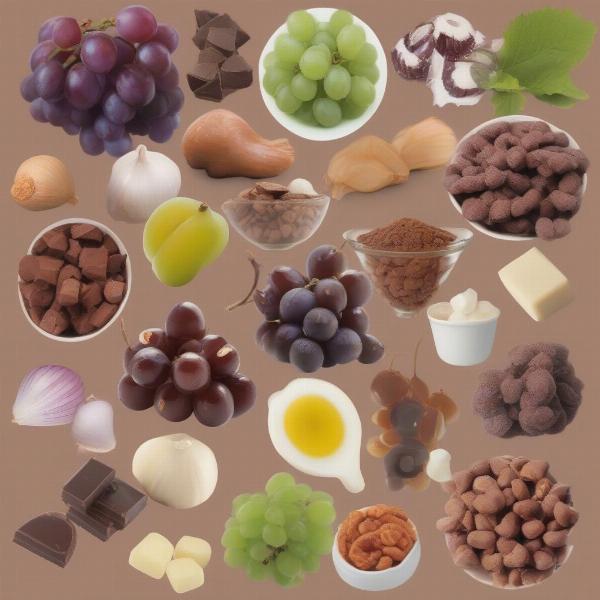Chocolate hot dogs might sound like a quirky culinary creation, but for dog owners, this combination represents a serious health hazard. Chocolate is toxic to dogs, and even a small amount, especially dark chocolate, can cause significant health problems. Understanding the risks associated with chocolate ingestion and knowing what to do in case of an emergency is crucial for every dog owner.
Why is Chocolate Toxic to Dogs?
Chocolate contains theobromine, a compound similar to caffeine that dogs metabolize much slower than humans. This slow metabolism leads to a buildup of theobromine in their system, causing various symptoms ranging from mild gastrointestinal upset to severe cardiac issues and even death. The darker the chocolate, the higher the theobromine concentration, making dark chocolate and baking chocolate particularly dangerous. Even white chocolate, while containing less theobromine, can still cause digestive upset due to its high sugar and fat content.
Recognizing the Signs of Chocolate Poisoning in Dogs
Early detection is critical when it comes to chocolate poisoning. Symptoms typically appear within 6-12 hours after ingestion and can include vomiting, diarrhea, increased thirst, panting, restlessness, increased urination, elevated heart rate, muscle tremors, and seizures. In severe cases, chocolate poisoning can lead to cardiac arrhythmias, respiratory failure, and even death.
What to Do if Your Dog Eats Chocolate
If you suspect your dog has ingested chocolate, contact your veterinarian or an emergency animal hospital immediately. Provide them with information about the type and amount of chocolate consumed, as well as your dog’s size and breed. The veterinarian may induce vomiting or administer activated charcoal to absorb the theobromine. Prompt treatment significantly increases the chances of a full recovery.
Preventing Chocolate Exposure in Dogs
Prevention is always the best approach. Store all chocolate products, including baking supplies and holiday treats, out of your dog’s reach. Educate family members, especially children, about the dangers of chocolate for dogs. Never leave chocolate unattended on countertops, tables, or in easily accessible locations. Be mindful of guests who may not be aware of the risks and ensure they keep chocolate away from your furry friend. Even seemingly harmless items like chocolate-flavored medications or protein bars can contain enough theobromine to be harmful.
Other Foods to Keep Away from Your Dog
While chocolate poses a significant threat, several other foods are also toxic to dogs and should be avoided. These include grapes, raisins, onions, garlic, macadamia nuts, xylitol (an artificial sweetener), and alcoholic beverages. why is my dog shaking and panting Keeping these foods out of your dog’s reach is essential for their health and well-being.
 Foods that are toxic to dogs
Foods that are toxic to dogs
Conclusion
Chocolate and dogs are a dangerous combination. Understanding the risks associated with chocolate ingestion, recognizing the signs of poisoning, and taking preventative measures are vital for responsible dog ownership. By being vigilant and informed, you can help ensure your canine companion enjoys a long, healthy, and chocolate-free life. papitas para hot dog Remember, a safe dog is a happy dog.
FAQ
- How much chocolate is toxic to a dog? The toxic dose of theobromine varies depending on the type of chocolate and the dog’s size. Darker chocolate is more dangerous.
- What are the first signs of chocolate poisoning in a dog? Early signs include vomiting, diarrhea, increased thirst, panting, and restlessness.
- Can a dog recover from chocolate poisoning? With prompt veterinary treatment, many dogs recover fully from chocolate poisoning.
- What should I do if I think my dog ate chocolate? Contact your veterinarian or an emergency animal hospital immediately.
- How can I prevent my dog from eating chocolate? Store all chocolate products out of your dog’s reach and educate family members about the dangers.
- Are there any other foods that are toxic to dogs? Yes, other toxic foods include grapes, raisins, onions, garlic, macadamia nuts, xylitol, and alcohol.
- What is the best way to keep my dog safe from toxic foods? Vigilance, education, and responsible storage of potentially harmful substances are key. christmas and dogs quotes
ILM Dog is a leading international online resource dedicated to providing dog owners worldwide with reliable and practical information on all aspects of dog care and upbringing. From breed selection and health advice to training tips and nutrition guidance, ILM Dog offers a wealth of expert-backed resources to help you provide the best possible care for your canine companion. 100 beef hot dogs We cover a wide range of topics including breed selection, health and medical care, training, nutrition, grooming, and product recommendations. carnival king hot dog roller Contact us today via email at [email protected] or phone at +44 20-3965-8624 for any questions or inquiries.